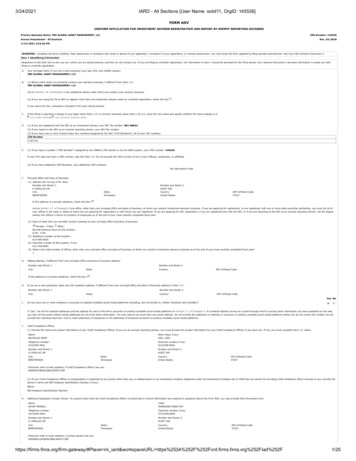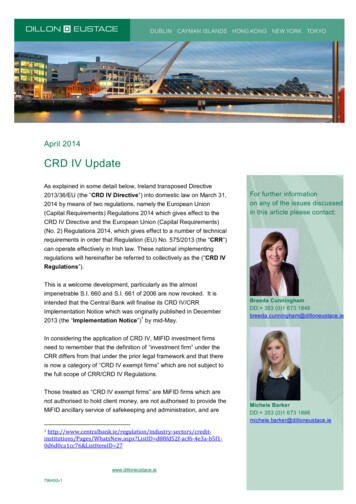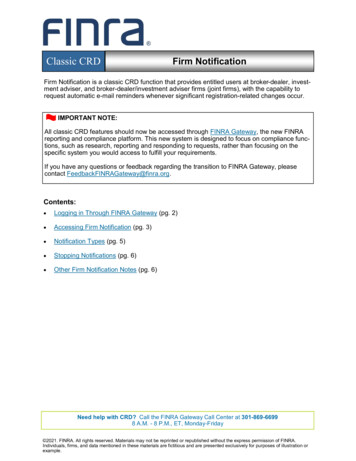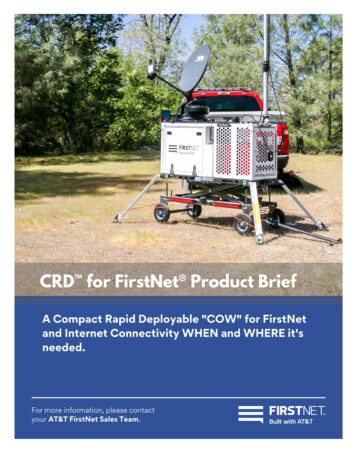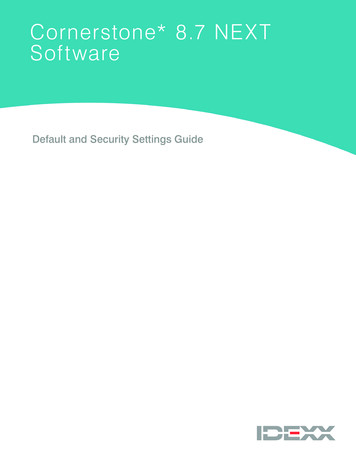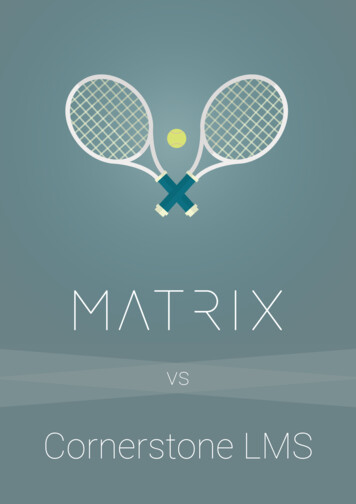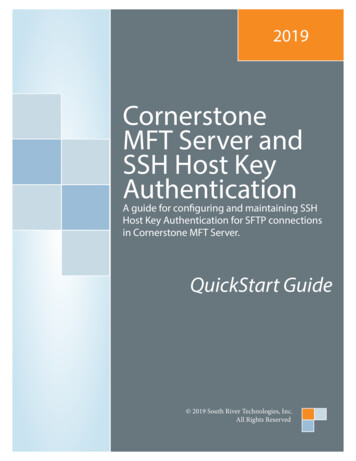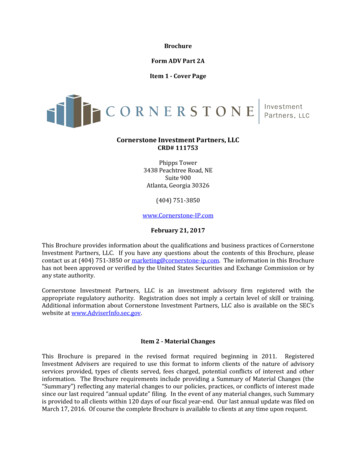
Transcription
BrochureForm ADV Part 2AItem 1 - Cover PageCornerstone Investment Partners, LLCCRD# 111753Phipps Tower3438 Peachtree Road, NESuite 900Atlanta, Georgia 30326(404) 751-3850www.Cornerstone-IP.comFebruary 21, 2017This Brochure provides information about the qualifications and business practices of CornerstoneInvestment Partners, LLC. If you have any questions about the contents of this Brochure, pleasecontact us at (404) 751-3850 or marketing@cornerstone-ip.com. The information in this Brochurehas not been approved or verified by the United States Securities and Exchange Commission or byany state authority.Cornerstone Investment Partners, LLC is an investment advisory firm registered with theappropriate regulatory authority. Registration does not imply a certain level of skill or training.Additional information about Cornerstone Investment Partners, LLC also is available on the SEC’swebsite at www.AdviserInfo.sec.gov.Item 2 - Material ChangesThis Brochure is prepared in the revised format required beginning in 2011. RegisteredInvestment Advisers are required to use this format to inform clients of the nature of advisoryservices provided, types of clients served, fees charged, potential conflicts of interest and otherinformation. The Brochure requirements include providing a Summary of Material Changes (the“Summary”) reflecting any material changes to our policies, practices, or conflicts of interest madesince our last required “annual update” filing. In the event of any material changes, such Summaryis provided to all clients within 120 days of our fiscal year-end. Our last annual update was filed onMarch 17, 2016. Of course the complete Brochure is available to clients at any time upon request.
Item 3 - Table of ContentsPageItem 1 - Cover Page . 1Item 2 - Material Changes. 1Item 3 - Table of Contents . 2Item 4 - Advisory Business . 3Item 5 - Fees and Compensation . 5Item 6 - Performance-Based Fees and Side-By-Side Management . 7Item 7 - Types of Clients . 7Item 8 - Methods of Analysis, Investment Strategies and Risk of Loss . 7Item 9 - Disciplinary Information . 12Item 10 - Other Financial Industry Activities and Affiliations . 12Item 11 - Code of Ethics, Participation or Interest in Client Transactions and Personal Trading . 13Item 12 - Brokerage Practices . 14Item 13 - Review of Accounts . 15Item 14 - Client Referrals and Other Compensation . 15Item 15 - Custody. 16Item 16 - Investment Discretion. 16Item 17 - Voting Client Securities . 16Item 18 - Financial Information. 19Brochure Supplements . . . . . Exhibit APage 2
Item 4 - Advisory BusinessGeneral InformationCornerstone Investment Partners, LLC (“Cornerstone”) was formed in 2001 and provides portfoliomanagement services to its clients.Cornerstone is 100% owned by CIM Holdings LLC, which is 100% owned by current employees ofCornerstone. No single employee has a majority ownership. Please see Cornerstone InvestmentPartners, LLC Brochure Supplements, Exhibit A, for more information on the individuals whoformulate investment advice and have direct contact with clients, or have discretionary authorityover client accounts.As of December 31, 2016, Cornerstone managed 2,609,740,244 on a discretionary basis, and 108,566,515 of assets on a non-discretionary basis.SERVICES PROVIDEDCornerstone serves four primary types of clients: Institutional clients, Wrap Account Clients, HighNet Worth clients and Registered Investment Company clients. Institutional clients usually selectone or more of Cornerstone’s Portfolios in which to invest based on the needs of the Institution.Wrap Account Clients are referred by the Sponsor of the wrap program. The Sponsorrepresentative works with the client to decide which Portfolio(s) offered by Cornerstone may beappropriate for the client. (More information regarding wrap account management is detailedbelow.) At the outset of each High Net Worth Client relationship, Cornerstone spends time with theclient, asking questions, discussing the client’s investment experience, risk tolerance and financialcircumstances. Cornerstone’s approach to investing and its management style is explained to theclient to be sure it is compatible with the client’s investment objective.Cornerstone also provides its research services to some financial intermediaries as a nondiscretionary investment advisor in Unified Managed Account Programs.Portfolio ManagementInstitutional clients include, but are not limited to, public and private retirement plans, union andmanagement plans along with endowment and foundation accounts. Accounts in the institutionalrealm are mostly tax-exempt but may include taxable portfolios or entities. These institutionalclients can approach Cornerstone directly or through an intermediary. The direct approach wouldmost likely be the result of a review of peers within a performance database such as PSN oreVestment Alliance. These databases are a central repository of investment performance andstatistical data on managers both domestic and global. Clients then seek out those managers thatmeet their investment criteria. Clients can also find managers using an intermediary, generally aninvestment consultant. Investment Consultants are used either on a retainer or project basis toassist institutional clients in manager selection. Once managers are identified, institutional clientswill provide them with their specific investment guidelines and policy requirements, which detailall approved and/or restricted activity as it relates to their portfolio. Institutional clients are themost sophisticated users of our services.As described above, at the beginning of a High Net Worth Client relationship, Cornerstone meetswith the client, gathers information, and performs limited research and analysis as necessary tounderstand the client’s Investment Objectives and Guidelines. Cornerstone does not providePage 3
retirement, cash flow, tax or liquidity planning for its clients. The Investment Objectives andGuidelines will be updated from time to time when requested by the client, or when determined tobe necessary or advisable by Cornerstone based on updates to the client’s financial or othercircumstances.To implement the client’s Investment Plan, Cornerstone will manage the client’s investmentportfolio on a discretionary or a non-discretionary basis. As a discretionary investment adviser,Cornerstone will have the authority to supervise and direct the portfolio without prior consultationwith the client. Under a non-discretionary arrangement, clients must be contacted prior to theexecution of any trade in the account(s) under management. This can result in a delay in executingrecommended trades, which could adversely affect the performance of the portfolio. This delayalso normally means the affected account(s) will not be able to participate in block trades, apractice designed to enhance the execution quality, timing and/or cost for all accounts included inthe block. In a non-discretionary arrangement, the client retains the responsibility for the finaldecision on all actions taken with respect to the portfolio.Notwithstanding the foregoing, clients may impose certain written restrictions on Cornerstone inthe management of their investment portfolios, such as prohibiting the inclusion of certain types ofinvestments in an investment portfolio or prohibiting the sale of certain investments held in theaccount at the commencement of the relationship. Each client should note, however, thatrestrictions imposed by a client may adversely affect the composition and performance of theclient’s investment portfolio. Each client should also note that his or her investment portfolio istreated individually by giving consideration to each purchase or sale for the client’s account. Forthese and other reasons, performance of client investment portfolios within the same investmentobjectives, goals and/or risk tolerance may differ and clients should not expect that thecomposition or performance of their investment portfolios would necessarily be consistent withsimilar clients of Cornerstone.Sub-Advisory ServicesCornerstone serves as investment sub-advisor to a Registered Investment Company, theAdvisorShares Cornerstone Small Cap ETF (the “Fund”).Wrap Program ClientsCornerstone participates in a number of managed account/wrap programs sponsored bybroker/dealers who are also registered investment advisers (“Sponsors”). Clients of theseSponsors may pay a bundled fee that includes the investment management, custodial services andbrokerage commissions to the extent transactions are executed through the Sponsor. In caseswhere Cornerstone’s fee is not bundled with the Sponsor’s fee, Cornerstone’s fee is billed andcollected separately and is in addition to the Sponsor’s fee.In a managed account/wrap program, it is the Sponsor who has the primary client relationship andcontact. The Sponsor is responsible for evaluating the client’s needs and objectives, and assessingthe suitability of investment strategies, fee arrangements, and outside manager selection in thecontext of those needs and objectives. Once the Sponsor, in consultation with the client, determinesthat Cornerstone’s investment management services are appropriate for a client, the Sponsorrecommends Cornerstone to the client to manage all or a portion of the client’s assets. If engaged,Cornerstone would then manage the client’s assets in accordance with the selected investmentstyle. Although the Sponsor has the primary client relationship and contact, Cornerstone isavailable to communicate and/or meet with the client as the need arises or the client or Sponsorrequests on matters concerning the investment of the client’s assets managed by Cornerstone.Page 4
Retirement Plan Advisory ServicesEstablishing a sound fiduciary governance process is vital to good decision-making and to ensuringthat prudent procedural steps are followed in making investment decisions. Cornerstone willprovide Retirement Plan consulting services to Plans and Plan Fiduciaries as described below. Theparticular services provided will be detailed in the consulting agreement. The appropriate PlanFiduciary(ies) designated in the Plan documents (e.g., the Plan sponsor or named fiduciary) will (i)make the decision to retain our firm; (ii) agree to the scope of the services that we will provide.The Employee Retirement Income Security Act of 1974 (“ERISA”) sets forth rules under which PlanFiduciaries may retain investment advisers for various types of services with respect to Plan assets.For certain services, Cornerstone will be considered a fiduciary under ERISA. To the extent that thePlan Fiduciaries retain Cornerstone to act as an investment manager within the meaning of ERISA §3(38), Cornerstone will provide discretionary investment management services to the Plan. Withrespect to any account for which Cornerstone meets the definition of a fiduciary under DepartmentOf Labor rules, Cornerstone acknowledges that both Cornerstone and its Related Persons are actingas fiduciaries. Additional disclosure may be found elsewhere in this Brochure or in the writtenagreement between Cornerstone and Client. With respect to any account for which Cornerstonemeets the definition of a fiduciary under Department of Labor rules, Cornerstone acknowledgesthat both Cornerstone and its Related Persons are acting as fiduciaries. Additional disclosure maybe found elsewhere in this Brochure or in the written agreement between Cornerstone and Client.Discretionary Management ServicesWhen retained as an investment manager within the meaning of ERISA § 3(38), Cornerstoneprovides continuous and ongoing supervision over the designated retirement plan assets.Cornerstone will actively monitor the designated retirement plan assets and provide ongoingmanagement of the assets. When applicable, Cornerstone will have discretionary authority to makeall decisions to buy, sell or hold securities, cash or other investments for the designated retirementplan assets in our sole discretion without first consulting with the Plan Fiduciaries. We also havethe power and authority to carry out these decisions by giving instructions, on your behalf, tobrokers and dealers and the qualified custodian(s) of the Plan for our management of thedesignated retirement plan assets.Item 5 - Fees and CompensationGeneral Fee InformationFees paid to Cornerstone are exclusive of all custodial and transaction costs paid to the client’scustodian, brokers or other third party consultants. Please see Item 12 - Brokerage Practices foradditional information. Fees paid to Cornerstone are also separate and distinct from the fees andexpenses charged by mutual funds, ETFs (exchange traded funds) or other investment pools totheir shareholders (generally including a management fee and fund expenses, as described in eachfund’s prospectus or offering materials). The client should review all fees charged by funds,brokers, custodians, Cornerstone and others to fully understand the total amount of fees paid by theclient for investment and financial-related services.Portfolio Management FeesThe annual fee schedule, based on a percentage of assets under management, is as follows:Page 5
Institutional Client Large Cap Fee ScheduleFirst 10,000,0000.75%Next 10,000,0000.55%Thereafter0.35%Institutional Client Mid & SMID Cap Fee ScheduleFirst 10,000,0000.90%Next 40,000,0000.75%Thereafter0.50%Institutional Client Small Cap Fee ScheduleFirst 10,000,0001.00%Next 40,000,0000.75%Thereafter0.50%High Net Worth Client Fee ScheduleFirst 10,000,000Next 10,000,000Thereafter1.00%0.75%0.55%The minimum portfolio value is generally set at 3,000,000. Minimum annual fees may apply.Cornerstone may, at its discretion, make exceptions to the foregoing fee structures or negotiatespecial fee arrangements where Cornerstone deems it appropriate under the circumstances.Portfolio management fees are generally payable quarterly, in arrears. If management begins afterthe start of a quarter, fees will be prorated accordingly.Either Cornerstone or the client may terminate their Investment Management Agreement at anytime, subject to any written notice requirements in the agreement. In the event of termination, anypaid but unearned fees will be promptly refunded to the client based on the number of days that theaccount was managed, and any fees due to Cornerstone from the client will be invoiced or deductedfrom the client’s account prior to termination.Wrap Program FeesIn some instances, Cornerstone is retained under wrap fee arrangements offered or sponsored bycertain institutions which may be organized as a Broker/Dealer, a Registered Investment Adviseror both (each collectively referred to herein as a “Sponsor”). Clients participating in sucharrangements generally pay the Sponsor an inclusive annual fee to cover the cost of securitiestransactions executed by or through the Sponsor, as well as advisory and custodial servicesprovided. In some cases the Sponsor collects the entire fee and remits a portion to Cornerstone; inother cases Cornerstone may collect its fee separately. In either case the fee arrangements aredisclosed to the client. Each Sponsor determines if its fees are paid in advance or in arrears.Sub-advisory FeesCornerstone receives fees for the investment sub-advisory services provided to the Fund. Thesefees are a portion of the fees and expenses charged by the Fund to their shareholders. Please referto the Prospectus and Statement of Additional Information applicable to the Fund for moreinformation regarding the Fund’s fees and expenses.Page 6
Item 6 - Performance-Based Fees and Side-By-Side ManagementCornerstone does not currently have any performance-based fee arrangements. “Side-by-SideManagement” refers to a situation in which the same firm manages accounts that are billed basedon a percentage of assets under management and at the same time manages other accounts forwhich fees are assessed on a performance fee basis. Because Cornerstone has no performancebased fee accounts, it has no side-by-side management. While Cornerstone does not currently haveany clients with performance-based fee arrangements it may do so in the future without priornotice.Item 7 - Types of ClientsCornerstone serves pension and profit-sharing plans, corporations, state or municipal governmententities, other pooled investment vehicles, Registered Investment Companies, trusts, estates,individuals and charitable organizations. With some exceptions, the minimum portfolio valueeligible for conventional investment advisory services is 3,000,000. Minimum annual fees mayapply. Under certain circumstances and in its sole discretion, Cornerstone may negotiate suchminimums.Item 8 - Methods of Analysis, Investment Strategies and Risk of LossCornerstone believes that stock prices of large companies are more volatile than the underlyingfundamentals of a given company. This anomaly provides an opportunity for us, as disciplinedinvestors, to exploit security mispricing.Key tenets of our large cap investment philosophy1. Fundamentals Determine Value: Large companies have embedded characteristics that tendto persist. The focus of our investment research is to determine if a company’s historicalfundamentals are likely to continue into the future. Over the long-term, price and valuetend to converge as near term issues are resolved. If our assessment is correct, a companywe buy needs only to continue its past history to outperform. We see this as a much lowerrisk approach to investing than requiring that a company does something unproven orexceptional in order to outperform.2. Information is a Commodity: We believe the market is efficient in so far as it incorporates allcurrent available information. There is no sustainable advantage to be derived from tryingto uncover incremental material information that is not yet known by the market. However,the market price overly weights investor fears, hopes, forecasts, and expectations about thefuture that are often overly optimistic or pessimistic. We believe we have a better way ofprocessing information and that is our competitive advantage.3. Avoid Forecasting Inputs: Forecasting forms a precarious basis for any investment process.The ability to forecast the future accurately and consistently is extremely rare.Furthermore, to be useful, a forecast must be not only correct, but it must also be differentfrom the consensus (otherwise the forecast is already reflected in current prices). Relyingupon forecasts interjects an over-confidence bias to security selection that puts value atrisk.Page 7
Overview of the Investment ProcessThe investment team uses its internally developed investment model (Fair Value Model) to screenfor attractive companies. The model is based in financial theory; it identifies a company’s fair valuebased on operating and financial fundamentals. Risk is controlled at the stock level by focusing oncompanies with demonstrated financial strength, long-term profitability, and a stock price that isbelow intrinsic value.Universe: Cornerstone Investment Partners’ has constructed a universe of 800 large, liquidsecurities, including non-US companies, traded on US exchanges. Roughly 75 of these names areADRs, acknowledging that many large cap firms are multinational organizations and that thephilosophy persists regardless of domicile.The investment team makes adjustments to the reported data to put all companies on equal footingwith respect to their return metrics. Stocks are then ranked based on their current discount to fairvalue. Those companies trading at the largest discounts should theoretically provide higher returns.These stocks are then reviewed by the investment team to determine if the historical track record isrelevant and ultimately repeatable.Investment Analysis: The investment team begins work by analyzing the most attractive namesfiltering through our proprietary valuation screen. The investment team goes through these nameseach week and culls out those that would obviously not clear fundamental review. For example, aname that is in danger of going bankrupt may look very inexpensive, but the team will usually avoidthese names as we seek first to preserve capital for our clients. Stocks may be excluded because theteam is familiar with management and considers them weak, the competitive position is poor, or webelieve there are financial disclosure problems. This process of exclusion allows the investmentteam to spend greater time analyzing each surviving name.Determining Fair Value: Our investment team conducts fundamental research to identify theembedded characteristics that have enabled the company to achieve its long-term profitability andto ensure those characteristics are still in place. Embedded characteristics would include quality ofmanagement, patents, products, distribution, culture, brand value, etc.Cornerstone continues to use its valuation methodology throughout the selection process to adjustthe fair value for each company based on scenario analysis (continuing earnings trends, worst casescenarios, etc.) and sensitivity analysis. This is possible because our valuation work not onlyidentifies securities that appear undervalued, but also explains why they appear undervalued. Thisdifferentiating capability allows the investment team to direct their research on the keydeterminants of value. We judge companies on their relevant proven financial record and therepeatability of that record. The team will not value a company using unrealistic profitabilityassumptions or a level of growth the company has never achieved. We use a long-term investmenthorizon when evaluating the respective outlooks for each company.During the portfolio design stage of our investment process, it is our objective to include thosenames with the greatest margin of safety and the greatest chance of achieving fair value. Industryand sector weightings are strictly an outgrowth of our bottom-up, stock selection process.We use a model portfolio approach to ensure that all clients with like mandates receive similarholdings and weightings.Page 8
Key tenets of our small and mid-cap investment philosophy1. Fundamentals Determine Value: We use the market price of a stock today with the demonstratedfundamentals of the stock and determine what level of profitability and growth the market expectsthe company to deliver. With our fundamental research, we then determine where marketexpectations diverge from what the company has done in the past and is likely to do in the future.2. Information is a Commodity: There is no sustainable advantage to be derived from trying touncover incremental material information that is not yet known by the market. However, themarket price overly weights investor fears, hopes, forecasts, and expectations about the future thatare often overly optimistic or pessimistic. We believe we have a better way of processinginformation and that is our competitive advantage.3. Avoid Forecasting Inputs: Forecasting forms a precarious basis for any investment process.The ability to forecast the future accurately and consistently is extremely rare. Furthermore, to beuseful, a forecast must be not only correct, but it must also be different from the consensus(otherwise the forecast is already reflected in current prices). Relying upon forecasts interjects anover-confidence bias to security selection that puts value at risk.Overview of the Investment ProcessThe investment team uses a Cash Flow Return methodology to determine which stocks the marketis pricing with muted expectations for profitability and growth. This approach is based in financialtheory of discounted cash flow analysis;Universe: Cornerstone Investment Partners’ screens from a universe of roughly 2500 stocks.Stocks are only considered if they fit the market cap ranges of the market cap benchmarks of thestrategy.The team screens for names that ideally demonstrate repeatable growth, stable or improvingprofitability, a history of economic profit creation and a track record of sufficient length operatingunder a consistent business model. These stocks are then reviewed by the investment team todetermine if the historical track record is relevant and ultimately repeatable.Investment Analysis: The investment team begins work by analyzing the candidates with thegreatest mispricing. The investment team goes through these names each week and culls out thosethat would obviously not clear fundamental review. For example, a name that is in danger of goingbankrupt may look very inexpensive, but the team will usually avoid these names as we seek first topreserve capital for our clients. Stocks may be excluded because the team is familiar withmanagement and considers them weak, the competitive position is poor, or we believe there arefinancial disclosure problems. This process of exclusion allows the investment team to spendgreater time analyzing each surviving name.Determining Mispricing of Fundamentals: The investment team performs multiple valuationanalyses when evaluating a stock, utilizing different inputs for profitability (cash flows, operatingearnings) and growth (asset growth, earnings growth). If a stock appears to be mispriced, theinvestment seeks to determine the degree of business continuity risk associated with the companyin question through financial statement analysis. Through a thorough inspection of the company’sfinancial statements that includes but is not limited to interest coverage and free cash flowgeneration, the investment team can discern the degree of risk to the company’s businessPage 9
continuity. For companies with low business continuity risk, the investment team performsadditional research on the company’s business model. This stage of research is broad, but generallyseeks to determine whether or not the company’s business model is sustainable. Examples ofanalysis at this stage include an examination of the competitive landscape across the industry aswell as the company’s customer base. The investment team will also assess management throughan analysis of the company’s financial performance during their tenure. We use a long-terminvestment horizon when evaluating each company.During the portfolio construction stage of our investment process, it is our objective to construct aportfolio of the stocks we have the greatest conviction that the market has mispriced. In eachportfolio, we hold a fixed number of securities in order to create a dynamic tension between stocksin the portfolio and stock outside the portfolio. Each newly bought stock forces another stock out ofthe portfolio, and vice versa. Through the integration of the buy and sell decision, we forceourselves to have conviction in each name that we hold. Since we expect the source of ouroutperformance to be driven by bottom up stock selection, we seek to derive the vast majority ofthe active risk in the portfolio from stock selection, the idiosyncratic risk of the stocks we haveselected. We use a model portfolio approach to ensure that all clients with like mandates receivesimilar holdings and weightings.Investment StrategiesCornerstone’s strategic approach is to invest each portfolio in accordance with the investmentguidelines established for each client. This means that the following strategies may be used invarying combinations over time for a given client, depending upon the client’s individualcircumstances.Long Term Purchases – securities purchased with the expectation that the value of thosesecurities will grow over a relatively long period of time, generally greater than one year.Short Term Purchases – securities purchased with the expectation that they will be soldwithin a relatively short period of time, generally less than one year, to take advantage ofthe securities’ short term price fluctuations.Margin Transactions – a securiti
practice designed to enhance the execution quality, timing and/or cost for all accounts included in the block. In a non-discretionary arrangement, the client retains the responsibility for the final . that Cornerstone's investment management services are appropriate for a client, the Sponsor recommends Cornerstone to the client to manage .
